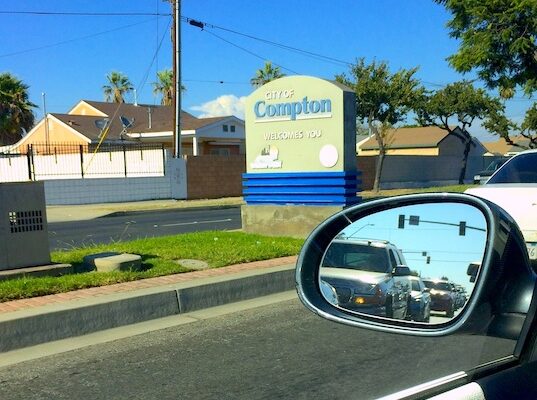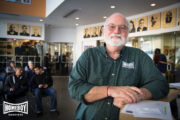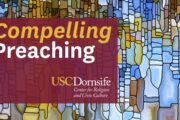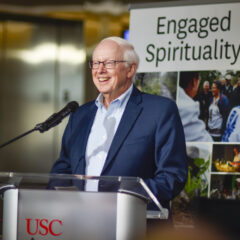As a part of our Religious Competition and Creative Innovation project, our research team meets once each month for “idea lunches” during which we have freewheeling discussions about what we’re seeing in the field. Last week, our theme was “theorizing L.A.,” and our conversation focused on readings from the so-called Los Angeles School of urban theory, as well as angles on religion in Southern California–all to help us think about how religion operates within particular geographic and social locations.
The primary difficulty of “theorizing L.A.” or any large urban area is that one model just never seems sufficient to explain the social and cultural reality that exists outside of academic discussions. Indeed, one of my criticisms of the Los Angeles School is that it is just so much armchair theorizing (“Southern California is like Disneyland!”), but without in-depth, empirical observation of what is really happening on the ground.
As I was driving home after our discussion, a large traffic jam (even by L.A. standards) prompted me to devise an alternative route to cover my 45-mile commute home. I had no good choices, so I decided to head across six miles of surface streets to connect to another freeway and thus avoid the huge traffic jam.
As I was driving, I had plenty of time to think about our earlier discussion of Los Angeles, and I decided to turn my attempt to avoid freeway backup into a field exercise and drive all the way home on surface streets to see whatever I could see along the way. I ended up driving through parts of 14 different cities as I crept across a swath of Southern California’s famous sprawl. My revised commute took me just over two hours.
What I observed in this vast yet familiar landscape contradicted much of what the L.A. School theorists argue. Of course their observations about unchecked growth, congestion, economic inequalities and the like are fairly apt, yet other elements of their argument just didn’t apply to the worlds I passed through. L.A. urban theorists like to distinguish themselves from the so-called Chicago School of urban theory (which itself has limitations), particularly in terms of how urban areas are governed. In fact, the general consensus is that “L.A.,” by which they mean the entire five-county Southern California region, is “ungovernable.”
True enough, Southern California lacks any sort of central governing structure, but is instead an enormous patchwork of dozens of distinct cities spread across five counties, one of which (Los Angeles) is the most populous county in the U.S., and another (San Bernardino) is the largest. Each city and county has its own governing structure, all of which means that there’s little hope for regional consensus on such matters as mass transit, environmental equity and the like.
Yet as I drove through this cross-section of “ungovernable” Greater L.A., I saw something other than chaotic urban sprawl. Based on what I know of the history of these cities, what I observed was an incredible range of social change and civic development. For example, as I drove through Compton, I did not see the city I knew when I was growing up—the Compton immortalized by “Boyz ’n the Hood.” Instead I observed a place that, despite many problems, looks to be working hard to create an environment where families, communities and businesses can thrive.
Likewise with other cities I saw on my journey. Paramount, for example, which also used to have a reputation as a pretty tough town. As I drove through, I suddenly realized I was at the intersection where my high school used to be, but I hadn’t even recognized it. Instead of rundown businesses and apartment complexes where knifings and fistfights took place on a daily basis, there were new condo developments, businesses and a nice greenbelt with large trees running down the middle of the road. I could offer additional examples of positive development, but the point is this: Local civic leaders may not see eye-to-eye with authorities at the county, state or federal level, but for the most part they appear to be doing what local citizens elect them to do.
This kind of localism is also apparent in expressions of religion in Southern California. The obvious examples are the many revivalisms and new religious movements that have been birthed in Los Angeles. Less obvious, unless you happen to be on an extended drive through different neighborhoods on surface streets, is how religion is emplaced within these communities. In my very informal survey, certain patterns emerged that might help us to think about the relationship between geographic place, political authority and how these relate to the ways religion perceived and enacted.
In cities that are closer to Los Angeles, religious buildings (such as churches) are situated more obviously on the main thoroughfares and are thus a more visible presence in these communities. These buildings tend to have little space surrounding them (whether parking lots or green space), and “storefront churches” are much more likely to spring up in these communities than in cities farther from L.A.’s old urban core. On the other hand, religious buildings tend to blend into constructed landscapes in more suburban environments, and they are less obviously religious than their counterparts in cities closer to LA.
At least in part, these differences reflect how and when these cities were established, and how they have been governed over time. In other words, local authorities write and enforce building codes and zoning laws that establish limits and create opportunities that determine how the built environment takes shape. This in turn influences perceptions of religion in different communities, as well as the relative ability of religious groups to be more-or-less free to do or act as they see fit.
Thus, in thinking about religion within specific contexts, we need to consider how the built environment—which is in large part an expression of the priorities of local authorities and the building codes and zoning strategies they impose—situates religion in the public places of different communities. Furthermore, these factors relate to how religious groups interact not only with each other but also how they enter the public sphere. In my mind, Southern California’s sprawl has its own local logic, which can help us to understand why L.A. is the way it is and why religion, at least in part, takes on the characteristics of its surroundings.
Richard Flory is the executive director of the USC Center for Religion and Civic Culture.






